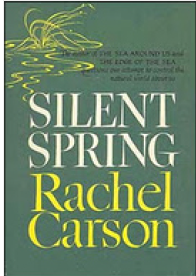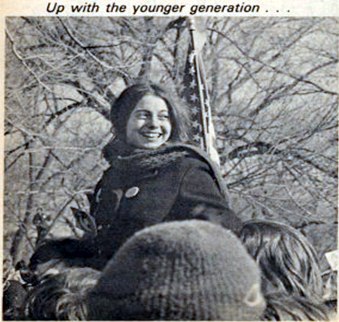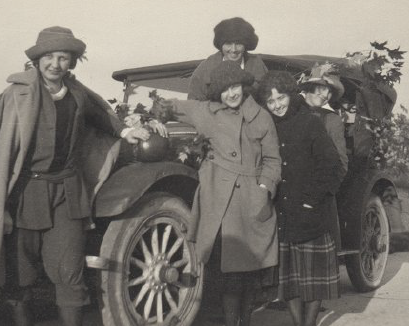First held in October of 1921, Mountain Day was an annual holiday sponsored by the Athletic Association that gave students and faculty an opportunity to enjoy sports, games, and a picnic outside of the city. The event was described as follows in the October 23, 1923 edition of The Arrow, the college newspaper: “It was a clear, cold day, and everyone there was in fine spirits. As soon as the picnickers reached the orchard, games of prisoners base, baseball and leap frog were started, and lasted amid much merriment, until lunch time. Lunch was served cafeteria style, and large quantities of wieners, sandwiches, pickles, gingerbread, and all the things that go with a picnic, were consumed by the hungry mob. After lunch a field meet was held, the events were carried off in a most business like manner, under the direction of Marian Frank [‘25]. A standing broad grin, discus throw (a paper plate serving as the discus), a three legged race, blind race and a shoe race, and a tug of war made up the list of events. The tug of war was brought to an untimely end when the rope broke. The Juniors won the meet and received a silver cup, (from Woolworths) with a blue ribbon triumphantly floating from the handle. The Sophomores received a dumbbell from the Gym, as a token of the fifth place in the event. Then came the event of the day—the Hare and Hounds chase. The Seniors and the Sophomores were the Hares, and proved most elusive; as the Hounds, Juniors and Freshman, had great difficulty in tracking them. After the weary racers had collected their belongings, they started for the car, feeling that Mountain Day was one of the college’s pleasantest traditions, and a most successful holiday for everyone.” The last Mountain Day was held at PCW in the 1950s, but similar events continued to take place at college campuses throughout the country, including women’s colleges Smith and Mount Holyoke.
Commenting on blog posts requires an account.
Login is required to interact with this comment. Please and try again.
If you do not have an account, Register Now.
Commenting on blog posts requires an account.
Login is required to interact with this comment. Please and try again.
If you do not have an account, Register Now.
 January 2012
January 2012
2012 marks the 50th anniversary of the publication of Silent Spring and the Jennie King Mellon Library is celebrating this milestone with a first floor exhibition of archival first editions, photographs, and papers from the Rachel Carson Collection housed in the Chatham University Archives. From now through January 30th, you can view images of Carson when she was a student at Pennsylvania College for Women in the late 1920s, a signed first edition of Silent Spring, a letter written by Carson, and materials documenting the book’s impact. The display also includes copies of Silent Spring available for checkout. One of the most important works of the twentieth century, Silent Spring was first serialized in three issues of The New Yorker beginning in June of 1962 and was published in book form later that year. Many cite the publication of Silent Spring, which called attention to the destructive impact of pesticides on our air, land, and water, as the foundation of the modern environmental movement. In response to the public outcry the book created, President John F. Kennedy formed a special government group to investigate the use and control of pesticides, and Carson testified before Congress in 1963 about new policies to protect the environment and the population. As a result of these efforts, DDT, a pesticide discussed in the book was banned in the United States in 1974, and the importance of conservation and environmental protection gained greater recognition in American life.
Commenting on blog posts requires an account.
Login is required to interact with this comment. Please and try again.
If you do not have an account, Register Now.
 October 2011
October 2011
Now on display on the Library’s first floor art wall is an exhibition of selected archival photographs and newspaper articles highlighting life at Chatham during the years of the Vietnam War. All of the materials were culled from the Chatham University Archives and specifically emphasize student and faculty opinions on U.S. involvement in Vietnam. The title of the display, “The Age of Protest”: Chatham During the Vietnam Era, comes from the 1966 commencement address of Robert S. McNamara, who served as Secretary of Defense from 1961-1968. McNamara, a major player in the escalation of the war, was the father of Kathleen McNamara Spears, who graduated from Chatham in 1966, the year her father was invited to speak at graduation and receive an honorary degree. Also included in the exhibition are images of student protests, campus peace groups, and evidence of student involvement in demonstrations for women’s liberation and civil rights. While prepared for the upcoming Alumni Reunion Weekend, the display will remain on view throughout the Fall semester.




In conjunction with the Pittsburgh Symphony Orchestra’s upcoming performance of Silent Spring, a symphonic tone poem created to honor the 50th anniversary of the publication of the seminal Rachel Carson book, the Chatham University Archives is presenting an exhibit titled Nature & Nurture: The Rachel Carson Legacy in Pittsburgh. On view in Heinz Hall from April 6 through April 22, the exhibition presents highlights from the collections of the University Archives that explore the roots of Rachel Carson’s interest in science and writing and the legacy of celebrating her achievements though music.
Chatham Archives exhibit Nature & Nurture: The Rachel Carson Legacy in Pittsburgh at Heinz Hall
Widely recognized for The Sea Around Us, Silent Spring, and countless articles that brought attention to the detrimental effects of widespread pesticide use, Rachel Carson’s connection to music isn’t frequently discussed. However, music played a major role in Rachel’s upbringing, as her mother taught piano lessons to local children in the family home and many days were spent setting Mother Goose rhymes to music.
Nature & Nurture exhibit essay in Pittsburgh Symphony Concert Program
Rachel remained a classical music fan throughout her lifetime, even writing liner notes for the National Symphony Orchestra’s recording of Claude Debussy’s Le Mer and speaking at an orchestra benefit luncheon. As a student at Chatham (then Pennsylvania Female College), Rachel evoked the sound of piano music in her literary club award winning essay, Broken Lamps. This essay is available online through the University Archives at this link.
Nature & Nurture exhibit from University Archives in Heinz Hall
The exhibition, Nature & Nurture: The Rachel Carson Legacy in Pittsburgh, spans Rachel Carson’s experience as a student and a few of the local, musical events that have honored her work as an environmental pioneer. The display includes photographs, programs, and documents from the 1995 Opus: Earth symphony concert to benefit the Rachel Carson Institute and the World Wildlife Fund.
Opus: Earth Program Cover Of particular note is a score to Silent Spring inscribed “in honor of Rachel Carson to her Alma Mater Chatham University” by the composer, Steven Stucky. The score was presented during an on-campus discussion of his piece and the legacy of Rachel Carson in 2011.
Score for “Silent Spring” inscribed to Chatham by composer Steven Stucky
The Pittsburgh Symphony Orchestra is generously offering discount codes for students, staff, faculty, and alums. Contact Student Affairs for more information. You won’t want to miss the special pre-concert lecture by Dr. Patricia DeMarco, former head of the Rachel Carson Institute and our region’s foremost Rachel Carson scholar.
Dr. DeMarco’s lecture will occur on Friday, April 20, 2018.
Can make the event? Check out the finding aid for the Collection on Rachel Carson or contact the Chatham University Archives & Special Collections to learn more about Rachel Carson `29 and her local legacy.
Commenting on blog posts requires an account.
Login is required to interact with this comment. Please and try again.
If you do not have an account, Register Now.